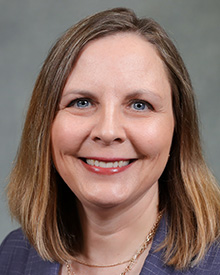Office: WRNH 103A | Phone: 308-865-8209 | Email: shafferjj@unk.edu

Julie Shaffer was named senior vice chancellor for academic affairs in April 2024 after serving as interim SVCAA since August 2023.
Shaffer joined the UNK Department of Biology in 1999 and was promoted to associate professor in 2004 and professor in 2010. She served as the department’s graduate program chair for seven years and online director for one year before becoming the department chair in 2017.
Shaffer has taught undergraduate and graduate courses while mentoring countless student researchers. With interests in microbial ecology and tickborne pathogens, she’s presented at numerous conferences and had her work published in a variety of academic journals. Her research projects have received more than $6 million in grant funding.
She has also served on several campus committees and academic program review teams and is a current fellow for the National Strategic Research Institute at the University of Nebraska.
Among her many awards and honors, Shaffer received the Pratt-Heins Award for Teaching in 2010 and Leland Holdt/Security Mutual Life Distinguished Faculty Award – the university’s most prestigious faculty honor – in 2014. She was instrumental in revising the curriculum for her department’s undergraduate and graduate programs while creating several courses in her area of expertise.
Shaffer earned bachelor’s degrees in biology and English from the University of Sioux Falls and a doctorate in biology with an emphasis in microbial physiology from the University of Nebraska-Lincoln. She’s a past president of the Nebraska Academy of Sciences and Missouri Valley Branch of the American Society of Microbiology and also has membership in the American Association for the Advancement of Science, National Science Teaching Association, Association of College and University Biology Educators, Entomological Society of America and National Association of Biology Teachers.